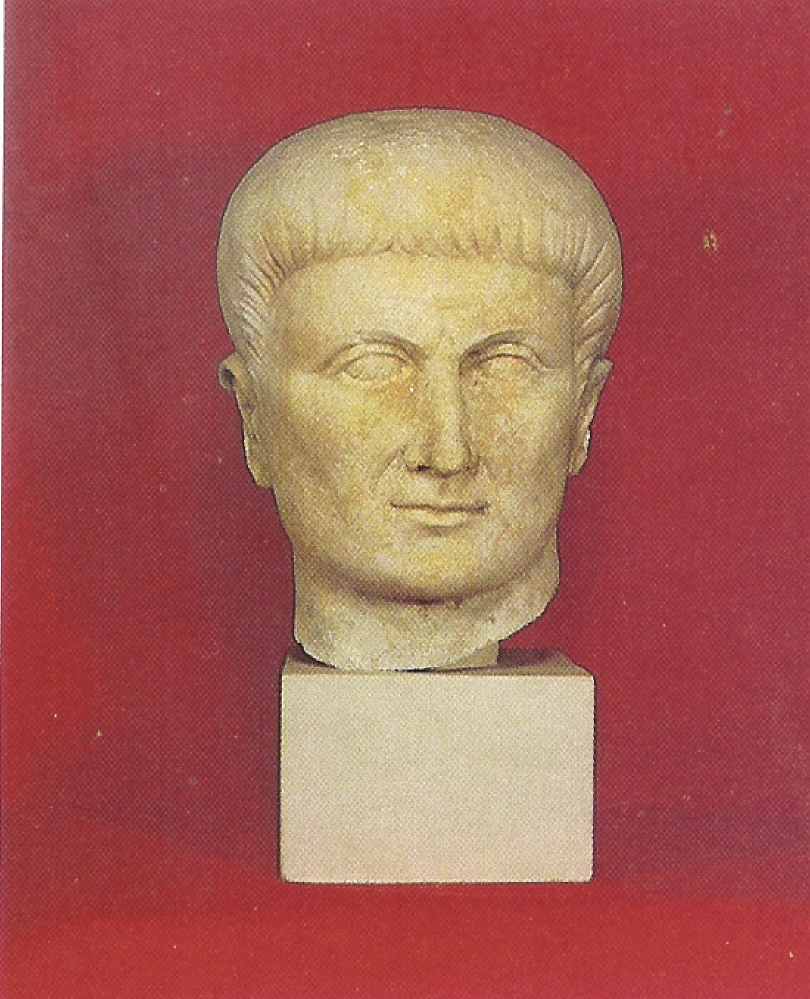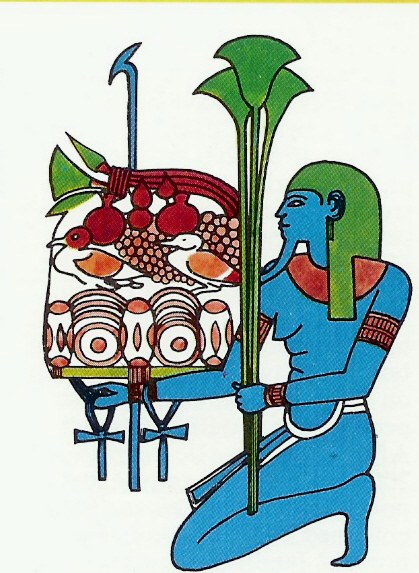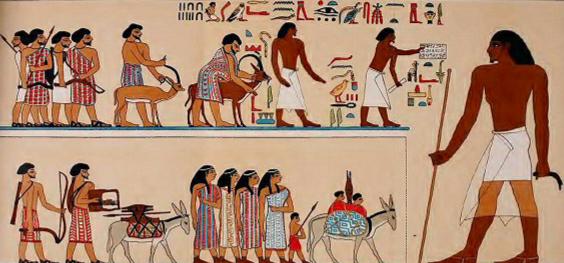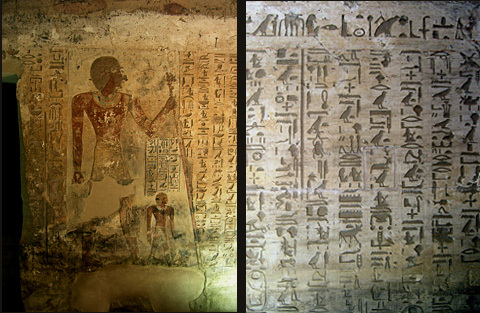FAITH ARCHAEOLOGY THE SOJOURN
|
The story is well known. It begins when a group of seventy, men, women and children, emigrate from the ancient Land of Canaan into ancient Egypt to escape famine. They are all relatives of Joseph, the son of Jacob, who because his brothers were jealous was sold into slavery. But even in slavery, Joseph is blessed and eventually becomes an important officer at the court of the Pharaoh. It is Joseph who becomes the salvation of his father, brothers and their families by inviting them, in the name of Pharaoh, into Egypt during years of famine… where they, and their descendants, remain for over four hundred years. In the course of time however, seventy persons becomes one million and centuries after entering Egypt, having multiplied greatly, the Hebrews are forced into slavery. And, for hundreds of years, Hebrew men, women, and even children, toil as slaves in Egypt, until finally, GOD sends a deliverer named Moses who leads the people out of slavery into freedom and into the Promised Land which eventually becomes Israel. When pondering this oft told story about ancient Egypt and the Biblical Exodus of the Hebrew nation from the Land of the Pharaohs many questions arise. Have you ever wondered about the Egyptian Princess who rescued the infant Moses from the Nile River? Have you ever wondered why the Egyptians after first inviting the Hebrews into Egypt made slaves out of them in subsequent generations? Have you ever wondered why a hereditary Pharaoh would turn his back on hundreds of years of history, abandoned the ancient gods of Egypt, and subsequently introduce a radical monotheistic form of worship into that ancient land… a religion centering upon a single all-powerful god he called Aten? Can these questions be answered? Yes, they can and they will be by the end of this piece… read on and learn the truth. But first a bit of explanation… The study of ancient Egyptian history, the language, literature, religion and art is called Egyptology. Many major Universities offer degrees in Egyptology, including academies for the elite such as Princeton, UC Berkeley, Oxford and Cambridge. However, the study of Egyptology rests on assumptions that may be true or may not be true. For decades now the artifacts upon which the discipline depends have been under the tightfisted control of the Egyptian Government. For decades throughout the recent past this meant the dictator Hosni Mubarak and his handpicked underlings. If you want access to Egypt in order to study artifacts you must get permission from dishonest bureaucrats. Can you envision liberal professors, their careers on the line, kowtowing spinelessly before notoriously corrupt bureaucrats in order to enter a tomb? So who controls the discipline? Recently, the government has changed and a new leadership is in charge in Egypt. Will there be a difference… who knows? But, even with all other factors being equal, there has always been one major difficulty within Egyptology… the confusion involved with assigning dates to specific events. The difficulties are many when attempting to establish dates from ancient sources. Therefore, often times assigning precise dates within Egyptology comes down to educated speculation. These variations have caused Egyptologists to come up with three different chronologies or schemes, which are known as the high, middle and low dates. Some experts adhere to the high chronology, others to the middle or low chronology. When investigating the Exodus we must keep these facts in mind. In the following paper we rely (more or less) on the high-date-scheme when speaking about the physical record. But we must keep in mind the present fact that there is no certainty involved when assigning specific dates to Egyptian artifacts. Remember, this discipline relies upon bits of stone and parchment that were covered over by desert sand for thousands of years and are interpreted by men and women who are desperately hoping to be mentioned in a National Geographic Special. The following example will illustrate the difficulty: Dr. Michael Dee, from the University of Oxford led a team of UK researchers and investigated the origins of civilization’s first ruler King Aha. Previously Pharaoh Aha’s reign had been dated using the usual techniques such as estimates based on ceramics discovered in burial sites. However, using mathematics, radiocarbon dating, archaeological evidence, and computer models, Dr. Dee’s scientists estimate that King Aha, came to power around 3111BC to 3045BC. The previously established date for the beginning of Aha’s reign was 500 years earlier. Think of it! The earlier estimates were off, by perhaps, as much as, 500 Years! The team’s research was published in the Proceedings of the Royal Society in September of 2013. For the purposes of our study however, we have an invaluable source… THE BIBLE! And, the holy bible---through the use of simple addition and subtraction---gives us pretty good dates for events that occurred during the period of…
So… let’s examine the evidence…
Accordingly, through simple addition we know there were 910 years from the time Joseph and his family entered Egypt to the date Solomon began to build the Temple in Jerusalem which has become known throughout the ages as… Solomon’s Temple. And, the date Solomon began to build the Temple is fairly well established (967 BC). Which means that Joseph and his family entered into Egypt around the year 1877 BC. Therefore, armed with these dates and relying on the bible and archaeology by the end of this discourse you will have learned some startling facts…
Have we peaked your curiosity? Read on loyal reader, read on…THE SOJOURNThe Holy Bible tells us the nation of Israel was held captive in Egypt over a span of 430 years (the Sojourn) however the account of this historical event, handed down to us in the Book of Exodus, doesn’t offer much detail, which has fueled debate for centuries. What is there about the ancient Hebrew’s Sojourn in the land of Egypt and their subsequent Exodus that arouses so much curiosity? One question that comes immediately to mind is: Who was the Pharaoh that welcomed the family of Joseph into Egypt? Another is: Why were the Hebrew’s enslaved? Still another… What is the date of the Exodus? And finally… Who was the Pharaoh of the Exodus? These are important questions for serious study and wherever the subject is discussed our questions ignite debate. The problem then becomes how to resolve this debate. One way to attempt resolution is to survey the evidence. But how should we begin? There are three authorities available that should prove invaluable to any such inquiry; the Holy Bible, archaeology, and expert opinion. Which allows us to narrow our search down to three areas…
So let’s begin with the most reliable record available, the Holy Bible.“And it came to pass in the four hundred and eightieth year after the children of Israel were come out of the land of Egypt, in the fourth year of Solomon’s reign over Israel, in the month Zif, which is the second month, that he began to build the house of the Lord.” (1 Kings 6:1 )Because there is general agreement plus, or minus, six years on the date Solomon ascended the throne in Israel we can assign the date 967BC to the fourth year of his reign with some degree of confidence. Which gives us the year 1447BC, 480 years earlier, for the Exodus. Hence, with these dates in mind, let us once again return to the Bible.“Now the sojourning of the children of Israel who dwelt in Egypt, was four hundred and thirty years.” (Exodus 12:40)Which gives us the year 1877 BC. So, who was Pharaoh at that time? Well, taking dating difficulties into consideration, we believe this date coincides with the reign of Sesostris III over Egypt. Accordingly, Sesostris III would be the Pharaoh who welcomed the Hebrews into Egypt to escape famine. So there, we’ve already answered two of the thorny questions we proposed. Or, have we? Instead of our date some experts totally ignore the biblical math and date the Exodus toward the reign of Ramses II (1297BC) and that is some 150 years after our date. Why this vast difference? And even more important… what occurred during that 430 year time period from 1877 BC to 1447 BC? Scripture goes into detail only on events that transpired toward the end of the Sojourn, so what do we do? It’s clear… if we want to learn more about this period we must turn to other sources.Maybe archaeology can aid us in our inquiry?The logical place to begin is at the beginning with the patriarch Joseph and his entry into Egypt. If we adopt the perspective of an Historian, immediately we’re faced with another difficult question. Why did the Egyptians so readily accept Joseph and his brethren into their midst? Those of us familiar with scripture know the answer, but what does the record reveal that might satisfy the secular mind? Turning to archaeology, we learn from the experts that the admission of nomads from outlying desert areas onto, and within, the borders of agricultural countries in the region was a common practice at all times. Such periodic migration served a practical purpose for host and nomad alike. It’s obvious how the nomads were served by this custom but what about the host? They benefited by a natural tendency on the part of the newcomers to defend their pastures thereby serving the host country as a sort of first line of defense against foreign invasion and affording them heightened security along their borders.All well and good however… but what about the specific case of Egypt? The historical record reveals that migrations were frequent across the Egyptian border because the nomad lands to the east of the Nile Valley were subject to periodic drought. Whereas the Egyptians, usually, managed to avoid drought by controlling the Nile through the use of extensive irrigation canals. If there were a particularly wide spread famine… it would likely effect the eastern lands first then eventually spread into Egypt. Famine, therefore, was the driving force. It was famine that brought nomads into the rich fertile lands of the Nile Basin. |
As in a specific case illustrated by a well-known wall painting found in an Egyptian tomb at Beni Hassan, Egypt---a small village situated near limestone cliffs that are the site of numerous royal tombs---the fresco depicts foreigners, typically referred to as Asiatics by archeologists, who are entering into Egypt.The photograph above shows a section of the fresco from Beni Hassan that depicts Pharaoh Amenemhet II leading a group of nomads into Egypt around 1900 BC. We know this represents Pharaoh Amenemhet II because the hieroglyphs included within the art work includes his name. Pharaoh Amenemhet II was the father of Sesostris II and the grandfather of Sesostris III. It is quite likely that either Sesostris II, or Sesostris III, was the Pharaoh who elevated Joseph to a position of prominence within his kingdom. The hieroglyphs within the fresco also indicate this was a family from an area coinciding with today’s Jordan… notice the clothing of the newcomers which is typical of Hebrew men and women. The number of immigrants is stated to be approximately 36 persons (Egyptians did not count women or children only men). The Egyptians are shown wearing white and their skin is red which is the usual way Egyptians are depicted in their art. The Asiatics however, are depicted as yellow skinned and they have beards… the Egyptians do not have beards… which also is typical for Egyptian art. The newcomers are bringing gifts to the superior Egyptians which would have been a requirement for them to be accepted. Were these men and women coming for a visit? Or were they a family escaping famine being welcomed by the Egyptians? It is certainly within the realm of possibility that this fresco is depicting the actual extended family of Joseph coming into Egypt to escape the seven year famine he had predicted. Whether or not they are, however, isn’t the point, the point being… nomads were quite often welcomed into the land. The large figure to the right, overseeing everything, is meant to depict Pharaoh, himself. Even if the immigrants shown in the Beni Hassan fresco are not Joseph’s family… the men and women depicted were entering into a land that had, since the beginning of the reign of Amenemhet II been---most experts believe---relatively prosperous.However, even though they were masters of irrigation, the Egyptians still had one insurmountable difficulty … how to get the Nile River to cooperate? Often the Nile would flood disastrously, leaving behind devastation which inevitably led to famine. With their fields flooded the harvest would be lost and the granaries left empty. And, only by careful planning could disaster be overcome which likely was the case when Egypt and surrounding areas were struck by a seven year famine. Just before the famine struck, Joseph’s fortunes were at low ebb. He had been betrayed by his brothers and sold into slavery and some years later was thrown into an Egyptian prison. So, how did he get out and become Pharaoh’s right hand man? Just a word or two in way of explanation… In ancient times dreams were important and in Egypt, Pharaoh was a god, and dreams were one way gods communicated with each other. So, when Pharaoh had a particularly vivid dream which his underlings were unable to interpret to his satisfaction the Pharaoh sought outside assistance in a matter that he considered to be vitally important. Well, we know from the bible that in, at least one case, Pharaoh did just that?Then Pharaoh sent and called Joseph, and they brought him hastily out of the dungeon: and he shaved himself, and changed his raiment, and came in unto Pharaoh. And Pharaoh said unto Joseph, I have dreamed a dream, and there is none that can interpret it: and I have heard say of thee, that thou canst understand a dream to interpret it. And Joseph answered Pharaoh, saying, It is not in me: God shall give Pharaoh an answer of peace. Genesis 41: 14 -16Thereafter, Joseph went on to interpret Pharaoh’s dream predicting a seven year famine to come. But, he didn’t stop there he also told the king that by careful planning the country could escape the worst effects of the drought. Accordingly, as it was not common practice for Egyptian rulers to elevate foreigners to positions of authority what should we deduce? What we do know is… Pharaoh, facing drought and famine, turned to the ablest administrator he could find.And that man was… Joseph.So there you have it… Joseph rises from slavery to become an important minister in Egypt.The Book of Genesis informs us that Joseph eventually forgave his brothers and brought his entire family (including his father Jacob whom GOD named Israel) into Egypt to escape the famine. Thereafter, finding a safe haven in their adopted land, the Hebrew people survived the lean years through the efforts of Joseph on behalf of Pharaoh and they prospered.“And Israel dwelt in the land of Egypt, in the country of Goshen: and they had possessions therein, and grew, and multiplied exceedingly. (Genesis 47:27)So what happened? Here we have the Hebrews safe and secure in Egypt… prospering. So what happened?Well, sometime after Joseph died, an event took place that proved disastrous for the growing nation within their adopted land… the Hykos Invasion! The Hykos, translated literally as “rulers of foreign countries” were a Semitic Race that began filtering down into the center of the Fertile Crescent from the northeast sometime around 1750 BC. These warrior nomads swept through Philistia, crossed over into Africa and began a conquest of most of Egypt a century later. Whereupon they established their capital at the city of Avaris in the area of Goshen, precisely where the Hebrews had settled, and initiated the Hykos Dynasties that would last until Egyptians under Pharaoh Ahmose reemerged nearly two centuries later and expelled them from the country.Because the Hykos, like the Hebrews, were Semitic nomads from the area around Syria and Canaan it has been suggested the two peoples were allies. Indeed, some experts have even made the assumption that the Pharaoh who welcomed Joseph into Egypt was one of the first Hykos rulers. However, this hypothesis does not withstand the spotlight of contradiction. Can we offer proofs that the Pharaoh who welcomed Joseph and his family into Egypt was not Hykos?Yes, we can… consider the fact that when the Egyptians finally rose up and expelled the Hykos from the country the Hebrews were not expelled from the country along with them. Why not? The only reasonable explanation is that the Hebrews had initially remained loyal to their Egyptian friends and as a result were enslaved by the Hykos.“And he said unto his people. Behold, the people of the children of Israel are more and mightier than we: Come let us deal wisely with them; lest they multiply, and it come to pass, that, when there falleth out any war, they join also unto our enemies, and fight against us, and so get them up out of the land.” (Exodus 1:9-10)Obviously the descendants of Joseph were not as numerous as the Egyptians surrounding them, but quite possibly their numbers did overshadow those of the occupation forces of the Hykos. The Pharaoh who is quoted in Exodus 1, verses 9-10, is most certainly one of the first Hykos rulers of Northern Egypt. As for the Pharaoh who welcomed Joseph we need only consider the following from the Book of Genesis…“… because the Egyptians might not eat bread with the Hebrews; for that is an abomination unto the Egyptians.” (Genesis 43:32)We know that the Hykos retained a power base in the Semitic lands to the East all during their days of hegemony over Egypt. Therefore it hardly seems likely they would harbor such attitudes toward other Semitic visitors onto their lands. On the other hand would we be surprised to learn that prejudice was characteristic of the highly cosmopolitan, thoroughly sophisticated Egyptians? Furthermore, we know the Egyptians harbored a definite abhorrence for shepherds. For example, cattle are often depicted on their bas-reliefs but sheep never are.Again quoting from Genesis…“… for every shepherd is an abomination unto the Egyptians.” (Genesis 46:34)Clearly this could not refer to the Hykos who were known to future generations as “Shepherd Kings” therefore the Pharaoh who welcomed Joseph into Egypt was an Egyptian not one of the Hykos conquerors. It was nearly a century after Joseph and his family entered into Egypt that the Hykos began their conquest. When the invaders entered the Nile Basin the Hebrews true to the memory of Joseph’s Pharaoh and their Patriarchs sided with the Egyptians and as a result were oppressed by the victorious Hykos.“Thereafter they did set over them taskmasters to afflict them with their burdens. And they built for Pharaoh treasure cities, Pithom and Raamses.” (Exodus 1:11)This reference in the scripture to Pithom and Raamses is often relied upon as evidence that the Exodus occurred toward the end of the reign of Ramses II (1292 BC to 1225 BC). And indeed he did initiate extensive building projects in the area of Goshen during his reign. Be that as it may however, Ramses was not the Pharaoh of the Exodus. The name Ramses translates as “begotten of Ra”. Ra was a sun god revered by the Hykos as well as the Egyptians. Indeed, there is a very good possibility the name was of Hykos origin and was a common name during their rule. Beyond all this, the ancestors of Ramses II were very likely these same foreign rulers. Did the Hykos build in Goshen using the pool of Hebrew slave labor they had established? Did they name at least one of their projects Raamses? The evidence suggests they did.For nearly two centuries the Hykos were supreme while the Egyptian Pharaohs made their capital in the South and were relegated to ruling over a portion of their own country from there. Not before Sekenenre became Pharaoh at Thebes did events unfold that would eventually lead to the downfall of the Hykos. Sekenenre sowed the seeds of revolt but died before embarking on the task. His son, Kamose, actually began the revolt that was later taken over and completed by his son, Ahmose I, with the capture of the Hykos capital sometime around the year 1580 BC. The capture was dutifully recorded on the walls of a tomb of one of Pharaoh’s officers, a ship’s captain also named Ahmose, at a place called El Kab (80 miles south of Luxor). The actual hieroglyphs that tell his story are quite extensive, however, a snippet from the ship’s captain’s saga goes something like this…“When the King besieged the town of Avaris…”The officer states,“I fought gallantly on foot in the presence of his majesty. I was thereafter promoted to the ship ‘Appearing in Memphi’”Thus ended Hykos rule in Egypt. |








